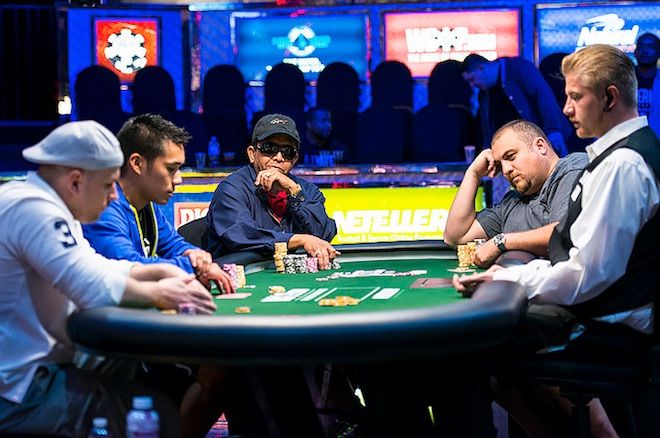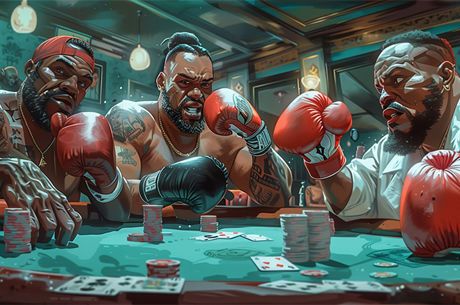10 Tips for Sit & Go Success: On the Money Bubble

Last week we discussed beginner strategy for the middle levels of a standard single-table sit & go in which the top three spots pay. This week we find ourselves on the money bubble with four players left.
Since we're playing poker for real money, our main goal at this point is not to be the next player out and miss the cash. In order to survive, we have to know how to shove and call correctly so we do not get forced all in by the blinds and antes.
Shoving Correctly
As the shortest stack, shove slightly wider than Nash on the second-shortest stack
The thing that makes shoving so profitable is fold equity. You can maximize your fold equity as the shortest stack by shoving slightly wider than suggested by the Nash equilibrium shoving strategy when the second-shortest stack is in the big blind. (See last week's article for more about using Nash as a guide for optimal shoving/calling.)
For example, if you have 10 BBs and shove from the small blind into a 50-BB stack in the big blind, he may call you close to correctly because losing does not hurt him very much. For this reason, you should just stick to the Nash shoving range in this spot.
On the other hand, if you shove from the cutoff, the big stack is less likely to call you from the button given that he does not have a blind invested and has to worry about the players left to act. If one of those other players has a 12- to 15-BB stack, he is less likely to call you correctly because losing would be devastating for him.
As a medium stack, shove moderately wider than Nash on all but the biggest stack
As a medium stack, you can put tons of pressure on everyone except the biggest stack. In fact, once the biggest stack folds, you can assume the role of the biggest stack even if you are tied for second as long as you are next to act. If you go all in, the other stacks will need a very good hand to call you.
As the biggest stack, shove extremely wider than Nash on everyone
On the money bubble of a SNG, the biggest stack is in the catbird seat. He has something I refer to as "big stack insurance" — he can bust the other players, but they cannot bust him. This allows him to shove incredibly wide.
For example, say there is a short stack with around 5 BBs. When he folds and you are next to act as the biggest stack with 50 BBs, you have license to shove just about any two cards on any medium stacks left to act (e.g., with 20 BBs). They know that if they just fold a few more hands, the short stack will likely be out. For this reason, they will be hesitant to gamble with the big stack with anything less than a premium hand. They are almost assured at least 20 percent of the prize pool and will not want to take the risk of getting nothing. (Single-table SNGs on most online poker sites pay 50/30/20 percent to the top three spots.)
Even if one of the medium stacks does decide to call and is fortunate enough to win, you will still have 30 BBs and a great chance at locking up 20 percent of the prize pool, not to mention also still having enough chips to play for more. This is less true when shoving on a fellow big stack whom you only cover by 10 BBs or so. Use reads to ensure this player understands how tightly he should be calling before you get too far out of line in this situation.
Calling Correctly
As the shortest stack, call according to Nash as you begin to lose fold equity
Generally, everyone should be tighter when calling on the bubble. However, there is one exception. If you are the shortest stack and you don't have much preflop fold equity, your only option is to showdown the best hand. When this is the case, calling is almost as good as shoving.
For example, let's say you have 10 BBs and the next shortest stack has 15 BBs. If a big stack shoves on you blind-versus-blind, you can choose not to call with a hand like K♥2♥ if you expect to have opportunities to shove on the 15-BB stack later.
However, this is not true when you only have 4 BBs. In this case, there is no reason to wait for a shove because your short stack has almost no fold equity. This means that you will likely get called, anyway, and often by multiple players at that. You may as well call the big stack's shove when you know you only have to beat one player who likely has a wide range.
Otherwise, call tighter
Unless you are the shortest stack with no fold equity, you should call tighter than Nash on the bubble regardless of your stack size.
If you are a short stack, but you still have decent fold equity, then you should prefer shoving over calling because this gives you two ways to win.
If you are a medium stack, then you certainly do not want to call off your stack in the presence of a short stack. You essentially have 20 percent of the prize pool all but locked up. This is not the time to gamble with a marginal hand.
If you are a big stack, it is almost criminal to call off with a marginal hand against a fellow big stack or medium stack for the majority of your chips. Furthermore, you may even want to call a wee bit tighter against the shortest stack in order to keep the bubble alive. If the other players are calling as tightly as they should, you can continue to win pots without showdown for as long as the bubble lasts.
Eventually, someone will pick up a good hand and call to bust the fourth player. Unless that fourth player happens to be you, congratulations — you've made it into the money! You've guaranteed yourself 20 percent of the prize pool. This is a nice consolation prize, but there is much more at stake.
We will discuss this next stage of the tournament — three-handed play — next week.
Also in this series...
- SNG Pros & Cons
- Assessing Structures and Speeds
- Introducing the Independent Chip Model
- Practical Applications of ICM
- Early Level Play
- Middle Stage Strategy
- Three-Handed Play
- How To Play Heads-Up
- Managing Your SNG Bankroll
Ready to start giving sit & gos a try? Put these tips into practice at PokerStars.
In this Series
- 1 10 Tips for Sit & Go Success: SNG Pros and Cons
- 2 10 Tips for Sit & Go Success: Assessing Structures and Speeds
- 3 10 Tips for Sit & Go Success: Introducing the Independent Chip Model
- 4 10 Tips for Sit & Go Success: Practical Applications of ICM
- 5 10 Tips for Sit & Go Success: Early Level Play
- 6 10 Tips for Sit & Go Success: Middle Stage Strategy
- 7 10 Tips for Sit & Go Success: On the Money Bubble
- 8 10 Tips for Sit & Go Success: Three-Handed Play
- 9 10 Tips for Sit & Go Success: How To Play Heads-Up
- 10 10 Tips for Sit & Go Success: Managing Your SNG Bankroll









